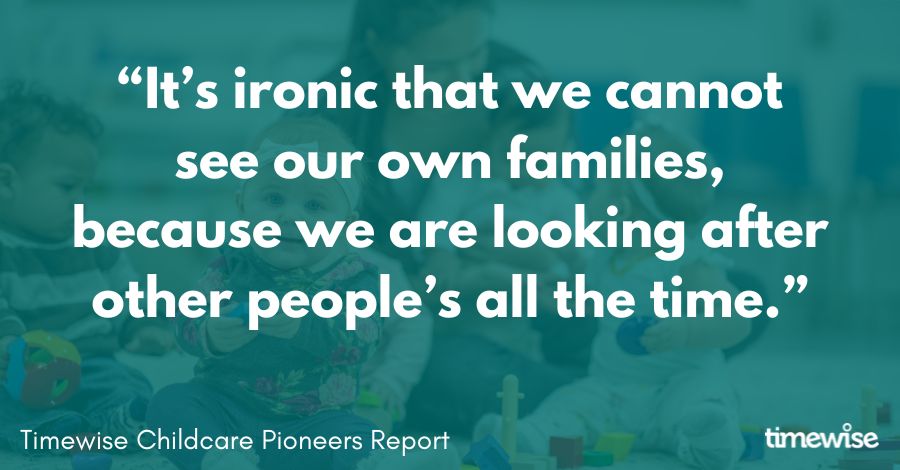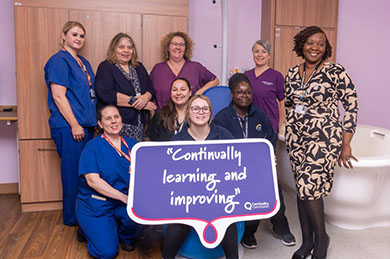

We spoke to workers in site-based roles about their perceptions of flexibility, its availability and its value to them. While they had little or no schedule control, they had a strong sense that things could and should be different.

By Dr Sarah Dauncey, Head of Partnerships and Insight, Timewise
We’ve been listening to workers in site-based roles over recent months in a series of focus groups, supported by Trust for London, to understand their views on flexible working and their experience of it in their workplace. Insights gained through these conversations are vital to inform our activity with employers and recommendations to drive positive change. There is now mounting evidence showing that control over working pattern is an important element of job quality, contributing to people’s sense of job satisfaction and wellbeing. It’s associated with healthy work.
And yet in spite of this evidence, there are millions of workers who not only have no control over their place of work but have minimal or no control over their schedules. The majority of workers (60%) are site-based and in customer facing or operational roles that couldn’t easily be worked from home. This is a feature of industry but also of job role and level of seniority. To put it simply, managers are more likely to get the option to work some of their time at home and to be able to flex their working hours whereas lower-paid workers have less choice. Their place and pattern of work is often fixed.
Recent Timewise research highlighted this ‘two-tier’ workforce, finding that almost a third of the workforce miss out on the benefits to health and work-life balance associated with flexible work.
The participants we engaged in our research represent a large part of the workforce. They worked in roles in construction, retail, health and transport. They recognised that flexibility was expected of them and was a requirement to get a job and keep it. They saw a clear distinction between “having” flexibility and “being” flexible. Their experience was that flexibility was all on them and wasn’t extended to them in return. One participant clearly articulated the impact of this: “Always being expected to be flexible can make you feel undervalued. It makes you feel your activities aren’t important.”
While their employers didn’t offer them any flexibility, they were very aware of it and of the difference it might make to their lives. This centred on having some sort of time-based flexibility to adjust start-finish times or condense or reduce working hours. Their understanding of what might be possible came through comparison with others working in different roles within their organisation or with friends and family working in entirely different jobs. They had a strong sense that “things could be different”. “Change can happen. The roster can change.”
The workers we spoke to felt trapped in systems that harmed their work-life balance. Parents with caring responsibilities described being placed in impossible situations at times – rigid patterns meant they were often unable to meet the needs of their children, creating a sense of guilt. Their awareness of the possibilities of organising work differently intensified their sense of frustration. They regarded their managers as stuck in “old school” ways, led by a fear of risk and a sense that “this is how things are always done.” The reluctance among managers to pursue change and explore alternative ways of working further contributed to workers’ low sense of worth. Systems and processes could change, but it’s too much of a “hassle” to do so.
This experience of inflexibility contributed to participants’ sense that they had poor work-life balance while also exposing some managers’ reluctance to give time and thought to workers’ circumstances beyond work. “I would rather take flexible working over a pay rise. It would make me a happier person.”
Participants recognised the impact of flexibility on their work-life balance, but also on their productivity. “We are all being held back by old-fashioned attitudes to work.” There was an overwhelming sense of lost potential resulting from working in contexts where they felt devalued and not fully trusted to work more autonomously.
When thinking more broadly about job quality and the elements of it, flexibility was seen as key. People want it, think that it’s possible and feel that they’re devalued through the lack of it. Their sense that it could be introduced with relatively few adjustments and low levels of risk just intensified their sense of not being worth the effort. When factoring in participants’ views that they would be more productive and loyal if trusted more and given flexible options. This is definitely an area for employers to reflect on given the level of emphasis on improving workplace performance and productivity in the current economic climate.
Our conversations highlighted the level of frustration experienced by workers resulting from a lack of flexibility and the need for workplace innovation for a complex of reasons: inclusion and belonging, work-life support, wellbeing and productivity. They also show that for reforms to be effective they need to be driven by an empathetic management approach.
When we asked our participants to “think big” and consider the sort of changes they would like to see in their workplace to improve their worker experience in the future and enhance their work-life balance, what was striking was the level of agreement. What they most wanted to see was more empathetic managers who considered their individual circumstances and their lives beyond work. They felt that once this was in place, flexibility would ensue.
These insights are critically important for employers and policymakers focusing on flexibility and how to make it work for all. Empathetic management shouldn’t have to be a recommendation for our workplaces, it should be a given. Yet it isn’t and too often it’s the primary barrier to flexibility being introduced or implemented effectively. This chimes with evidence found by CMI on the harm caused by bad managers, to individual employees and to organisations’ productivity. One in four people in the UK workforce holds a management role but only 27% of workers describe their manager as ‘highly effective’. This has implications for retention as manager behaviour has a sizeable impact on the likelihood of employees leaving their job.
Increased investment in training managers by employers is required to ensure flexibility is introduced and is working effectively to support employees’ work-life balance, performance and experience of job satisfaction. Such training would lead to wins for employees, but also for organisations looking to reduce staff turnover and sickness absence and increase productivity. Things can and should be different.
Published February 2025

By Nicola Pease, Principal Consultant, Timewise
We can all agree that any functioning society needs an excellent system of early years and childcare provision. At present, our high quality early years educators are managing to provide a great service, but many are stressed, exhausted and have little to no work-life balance. In short, it’s an early years system on the edge.
While issues around pay and progression loom large with no immediate resolution in sight, let’s look to what we can fix. Building on recent successes in other shift-based, site-based sectors such as nursing, construction and retail, Timewise launched a report following an in-depth two-year project in the early years and childcare sector. Thanks to support from JPMorganChase we were able to partner with two leading childcare providers: the Early Years Alliance and the London Early Years Foundation, and get close to childcare staff, in settings.
We analysed the industry’s challenges and assessed its potential with regards to improving staff wellbeing through changes to working patterns. Sometimes, even the smallest changes can make an enormous difference. We conducted all our research and analysis whilst keeping the experiences of children and parents front of mind. If this is going to work: it has to work for everyone.
We held a packed event in Westminster, with support from the Early Education and Childcare Coalition, to launch our subsequent report, Building the early years and childcare workforce of the future, with early years providers, policymakers and local and national government representatives. We collaborated on ideas and sharing ‘what works’ at settings across the UK. All with the experience of children and quality of education and care, front and centre of our thinking. Read on, to find out more…
The early years sector is facing a perfect storm – the expansion of 30 hours funded childcare will require an additional 35,000 staff across the UK, yet 78% of providers in a recent survey said they are already struggling to attract people to a sector that is not competitive on pay or working conditions. 62% of the workforce earn less than the living wage, with pay rates similar to roles in retail and hospitality, that are arguably less physically and emotionally demanding – and sometimes offer more flexibility in terms of what shifts and hours people can work.
There is also an increasing number of pressures on our early years educators which is driving up their workload and making the job harder. For example a growth in the demand for longer-hours provision to meet the needs of parents and (as was raised numerous times at our event), a hugely increased number of children presenting with SEND. All this notches up the pressure gauge.
The research found that nearly two-thirds of staff in group-based settings have said they do not have good work-life balance.

Part-time work across the sector has fallen in the majority of settings since 2018-19 with flexible working options generally achieved through the use of casual, agency or bank staff.
Managers recognised the potential benefits of offering flexible working but were concerned about continuity of care, maintaining staff-child ratios, meeting training standards, ensuring fairness and managing team dynamics. As one person described life in a nursery, “It’s a constant jigsaw.”
At the roundtable we heard a clear call to value those working in Early Years more highly, recognising that, “It’s not just about numbers, it’s about ensuring those who care and educate are energised, valued and motivated to do so.” There was an acknowledgement that emotional resilience is key in a workplace that demands a high level of emotional investment in children’s development and needs. And a sense that there is a need to better balance the workloads and schedules of those in such an intense working environment, to better support physical, mental and emotional wellbeing.
Increasing access and opportunity for the sector is a challenge, but through the research and numerous examples of good practice, it was proven to be possible within the operating constraints of the sector – all with the voice of the child front and centre. Innovative work practices included split-shift patterns (read Ruth’s story on page 11 of the report) and recruiting lunchtime assistants (page 18 of the report), housekeepers or tea-time assistants who enable flexibility across the wider teams. As Neil Leitch, Chief Executive of the Early Years Alliance put it, “You have to be creative. Continuity is critical but that does not mean you need always to see the same person.”
And it can also be used to enhance an organisation’s management capabilities. As June O’Sullivan OBE, the Chief Executive of LEYF said, “We need to think creatively about flexibility, in its wider context. For example, think flexibly about how you think about succession planning. It can help planning the next steps for staff or an experienced manager phase their retirement slowly, while helping a new manager to build their skills and knowledge.”
At a national level, Timewise is calling for a workforce plan that includes flexible working as a key strategic pillar. We estimate that a recruitment drive based around part-time and flexible working could attract staff to fill the equivalent of 17,850 full-time vacancies. That’s half the 35,000 shortfall the UK currently faces, to meet the expansion of 30hrs/week funded support.
Locally, we need authorities to bring networks of childcare providers together to share learnings, consider challenges and how to overcome them by exploring innovative practices such as sharing of bank staff. There was real momentum at our event around this idea – clearly they have a real ‘binding’ role to play. And for childcare providers themselves, we need to see a shift away from an individualised request-response model of flexibility towards a more pro-active whole-setting approach that encourages creativity and innovation and enables staff input into working patterns. To support this, Timewise have created a series of toolkits and resources for managers, which can be found here.
There is no magic wand with which to fix the staff and people problems that the early years sector is facing. But creating good standards of flexible working, in an industry where 98% of employees are women, many of whom have their own caring responsibilities, is not just good business sense. It’s a way to improve wellbeing and the lives of those playing the vital role of nurturing our future generations.

By Nicola Pease, Lead Principal Consultant
With the publication of the Employment Rights Bill, it was anticipated that the right to disconnect would be one of the raft of new rights for employees. However, it seems that this particular element of the legislation will instead be progressed through a Code of Practice. Although it will not become a statutory right, it remains a key pillar of Labour’s plan to Make Work Pay. In this article, we’ll explore what it’s likely to mean for employers and workers, and how best to prepare.
The government’s intention behind this new Code of Practice is to improve productivity and morale and promote work-life balance. The commitment is set out as follows:
“We will bring in the ‘right to switch off’, so working from home does not result in homes turning into 24/7 offices. We will follow similar models to those that are already in place in Ireland and Belgium, giving workers and employers the opportunity to have constructive conversations and work together on bespoke workplace policies or contractual terms that benefit both parties.“
Certainly, advancements in technology and the increase in hybrid working arrangements contribute to an ‘always on’ culture – where employees feel they are expected to be available and contactable outside of their working hours. A recent study by IOSH found an ‘epidemic’ of long working hours within the UK, and additionally found that 52% of respondents regularly check work related messages and emails outside of working hours, and 39% check and respond to work related messages whilst on annual leave.
This blurring of boundaries between work and outside-work life is what the government is seeking to address, and we at Timewise welcome the Code of Practice to help tackle what is a current and pressing wellbeing issue. Whilst some are concerned about a negative impact on productivity, we ascribe to the belief that well rested, healthy employees, who have protected time away from work, are likely to be more engaged and productive when they are working.
It appears the government are taking a similar approach to Ireland, which has an established a code of practice. This requires employers to come up with practical arrangements for guaranteeing periods when employees aren’t contacted and sets out obligations for time recording to demonstrate this.
Others including Australia, have also implemented their own formal right to disconnect from work, giving workers the right to refuse to monitor, read or respond to work-related communications without fear of dismissal or reprisals.
The language in Labour’s new deal suggests that they recognize that a ‘one size fits all’ approach won’t work on this – and that each workplace will be required to work out their own response to the new right, and how it can be implemented. In our experience, this seems sensible given the range of organisations and roles that will be impacted. Those organisations who genuinely engage their employees on this and work together to find the ‘win-win’, are the most likely to see positive shifts on organisational culture and behaviours. However, it’s unclear how employers are to be held accountable for upholding their responsibilities. We’d like to see the Code of Practice setting out clear requirements for monitoring and reporting to ensure it has an impact.
At Timewise, we support organisations of all shapes and sizes to innovate their working practices and design and implement new, flexible, ways of working. Our work focuses on finding the ‘sweet spot’ where the needs of the organisation and the needs of individuals can both be achieved. It involves being willing to look afresh at working practices and being willing to try something new. Co-designing solutions with managers and teams is our proven approach to achieving flexibility that works for all.
If you’re looking at your current workplace and can see that digital presenteeism and out-of-hours contact are regular occurrences, here are five things you can do:
The introduction of a Code of Practice provides an opportunity for managers and employees to revisit working patterns and arrangements, and ensure that they are working for individuals and enabling them to deliver productively in their roles. The right to switch off won’t automatically kick in at 5pm Monday to Friday in all cases – it’s about identifying what is reasonable and practical and ensuring the organisation’s culture and systems are set up to support this, and to harness the wellbeing and productivity benefits which will result.
Published October 2024
Changes in work: zero hours contracts
Changes in work: flexible working as a default Day One right

By Amy Butterworth, Consultancy Director
In October this year, the Government published its Employment Bill including the commitment to make flexible working a default right. This builds on the changes made in April this year which made it possible for employees to make a request on day one of their employment.
In terms of how this will be delivered, the Government has essentially tightened up the previous policy, putting more onus on the employer to accept any ‘reasonable’ request. Supporting guidance is expected to make it clear what the consideration process needs to be and to help employers understand how to apply the ‘reasonableness’ assessment.
In terms of supporting organisations to make this change, the key is to make sure it supports employers in delivering their business, as well as supporting individuals. It also important to reference all types of flexible working to ensure that the flexibility can be found which suits the role. This isn’t just about hybrid working. There will be more work to do to support employers to identify the flex that will work in each role and to support teams with multiple people working flexibly.
If delivered correctly, this change could enable thousands more people to access and stay in work. It will also benefit employers in terms of improving wellbeing and morale, and reducing sickness and turnover.
At Timewise, we’ve supported hundreds of organisations to transform their approach and attitudes towards flexible working. And as we’ve proved in our innovation work, there are ways to improve the options and choice someone has, even in shift- based and site-based roles.
Our work focuses on finding the ‘win-win’ where the needs of the organisation and the needs of individuals can be achieved. It involves being willing to look afresh at working practices and being willing to try something new. Being familiar with a whole range of ways to make jobs more flexible. And co-designing solutions with managers and teams.
Now that we know that this change will be happening, we encourage employers to look at their organisational culture and processes to ensure that flexible working is really integrated into how they work. The demand is there, so to reap the benefits of improved attraction and retention, ensure flexible working can be supported in every team and be part of your ways of working.
Published October 2024
Changes in work: zero hours contracts
Changes in work: the right to switch off

By Claire Campbell, CEO
In October the government published its Employment Bill including the right to guaranteed hours, ending exploitative zero hours contracts.
Zero tolerance to zero hours?
The focus on zero hours contracts and banning of exploitative work arrangements, in favour of more balanced flexibility – that works, both for employers and staff, has been a consistent element of the government’s plans since before the election.
The use of zero hours contracts in the UK has been growing and we now have over 1 million people on this type of employment contract as their main job. Although this only affects a small proportion of workers overall, some sectors are heavily reliant upon these contractual arrangements – including food and hospitality, health and social care and transport. Certain groups are also disproportionately affected – figures from the Work Foundation suggest that women, young workers (including those aged 16-24 who are not students), and black workers are all more likely than others to be employed on this basis.
A zero hours contract is one where the employer does not guarantee the worker any hours of work and instead offers work as and when it is available. They have been heralded in the past as the solution to flexible work, but this comes at a price – with only a tiny minority of people employed on these contracts having access to regular pay and rights. 3 in 4 workers on zero hour contracts are in severely insecure work.
The government has stated:
“We’re introducing a right to guaranteed hours reflecting the hours qualifying workers have worked during a reference period, anticipated to be 12 weeks. And we’re also enshrining into law the right to reasonable notice of shifts and a right to payment for shifts cancelled or curtailed at short notice”
Zero hours contracts will not be banned completely, but the rules around them will change. Those on both zero and low hours contracts will gain the right to have guaranteed hours if they work regular hours over a reference period, likely to be 12 weeks.
Workers will be able to bring tribunal claims and be awarded compensation. However, they will also be able to remain on zero hours contracts where they prefer.
Workers will also be entitled to reasonable notice of shifts (including details of how many hours are to be worked and when), changes to shifts and cancellation of shifts, and for payment if shifts are cancelled, moved or shortened.
So what can employers be doing now to prepare for this particular upgrade to workers’ rights?
The issue with zero hours contracts for many people is that they can provide a lot of flexibility for the employer and no stability or security for the individual, as they do not guarantee hours or income and make it hard to predict earnings week to week.
Ask yourself:
The government has opened a consultation on whether and how these rights could be extended to agency workers, which you can participate in here.
Further details will be needed including how long the reference period is, how it will be calculated, and how terms such as ‘regular hours’ and ‘low hours’ are defined.
Detailed, practical guidance will be needed to implement the planned changes, including a clear explanation for employers of what is meant by exploitative, and whether all zero hours contracts are in scope. If zero hours contracts are to be permitted in certain cases, the government will need to set out arrangements for monitoring this and ensuring workers’ rights are protected.
Whatever the detail that emerges, there is a clear ambition and opportunity here to improve the predictability and security of working hours and income for workers, which is a welcome direction of travel. At Timewise we look forward to contributing to the detail of the new regulations, and supporting more employers to create good quality jobs.
Published October 2024
Changes in work: flexible working as a default Day One right
Changes in work: the right to switch off

By Amy Butterworth, Consultancy Director
For too long, the UK has relied on the traditional 9-5, five-day-a-week working model, which we know no longer fits with modern lifestyles. While some industries, usually those with desk-based workers, have adopted flexible working with relative ease, spurred on by the pandemic, others with site-based or frontline workers have found it more challenging and risk being left behind. There is now a growing divide in the UK workforce between those who can work flexibly and those who cannot. Additionally, there is an increasing number of people out of work on sick leave, and employee burnout is on the rise too. With retention rates and employee wellbeing topping many leadership teams’ to-do lists, could flexible working be the answer?
Here at Timewise, we’ve long called for trialling different ways of working as we know the traditional 9-5 doesn’t work for everyone. That’s why we’re thrilled to be actively involved in the 4 Day Week campaign’s second pilot, which begins this Autumn. The second pilot has been expanded to give organisations greater opportunity to experiment with different kinds of flexibility, which aligns with the work we do, especially with front-line and site-based workers. Can the newly evolved four-day week trial pave the way for more flex, especially in traditionally hard-to-flex roles?
The first four-day week pilot saw 61 organisations move to a four-day week without a pay loss for workers. Organisations reduced working hours by an average of 6.6 hours to reach a 31.6-hour week and gave their employees one full day off a week, either on a universal or staggered basis.
The results led almost every company (92%) to continue with a four-day week, with many citing its positive effects on employee wellbeing, business performance and improved retention. While the initial pilot reaped encouraging results, it’s important to note that the majority of people involved were desk-based workers. From our experience, time-based flexibility can be challenging to manage and it’s unlikely this ‘one-size fits all’ approach will work for all organisation types and workers.
Which is why we’re thrilled the 4 Day Week campaign is evolving to give organisations the opportunity to try different kinds of flexibility. This could be shorter working weeks, flexible start and finish times, a nine-day fortnight, or compressed hours. As this is our sweet spot, we had to get involved and lend our knowledge and experience to the programme. We believe this new pilot will give organisations with ‘hard-to-flex’ roles the opportunity to innovate in a low-risk way as we know from our pilots in a range of sectors, including construction, nursing, retail and teaching. And we also know that changes to make flexible working more widely available can pay for themselves in just a few years through reduced sickness absences and improved staff retention.
The 4-Day Week campaign is an opportunity for organisations to get creative, especially those that have frontline or site-based workers, who have traditionally hard-to-flex roles. It comes at a time when we’re hearing of more organisations trialling new ways of working, which can only lead to more data and better decision-making as a result.
South Cambridgeshire District Council recently experimented with a shorter week for desk-based workers before expanding its trial to include refuse collection workers. Despite criticism, the Council continued with its plans, which saw changes to routes, collection days and extra staff. This has resulted in fewer sick days, less absenteeism, and better overall retention.
Another example is retailer Wickes, who we worked with to pilot a new approach to flexible working. The pilot made flexible working a reality for store managers, which had a knock-on effect on the company’s ability to attract and keep staff. It’s now being rolled out to more managerial roles.
We firmly believe that pilots are valuable. They allow organisations to test and develop innovative workplace solutions, learning and fine-tuning along the way, before committing to rolling out new ways of working, increasing the likelihood of success and sustainability. We have extensive experience in this area and will be sharing key learnings and watch-outs with pilot organisations.
Organisations of all types are encouraged to sign up for the six-month pilot, which begins in November. Throughout the pilot, organisations will benefit from support and guidance, tailored to their needs. The University of Cambridge, Boston College, and the Autonomy Institute will conduct an impact analysis and the results will be presented to the Government in Summer 2025.
This pilot is an exciting opportunity for organisations to innovate and implement flexible working arrangements that support their employees’ needs. The experiences and results from this pilot can pave the way for others too, especially in industries that are reluctant to flex. Timewise’s CEO Claire Campbell, said: “This is a great opportunity to trial something which will benefit worker health and retention. Whether you work in a warehouse, a care home or behind a desk – we foresee a fairer flexible future for all and the first employers to step forward for this trial, will be a part of that.”
Find out more about the 4 Day Week Campaign pilot.
Published August 2024

By Dr Sarah Dauncey, Head of Partnerships and Insight, Timewise
Since the pandemic, numerous studies have highlighted the benefits of hybrid and remote working for employees. Hybrid working models have been found to have positive impacts on workers, especially in relation to health and happiness. While it’s great to see this evidence showing the value of place-based flexibility, what about the millions of workers who can’t access it? The majority of the workforce (60%) are site-based and shouldn’t miss out on the advantages associated with having autonomy and control over working patterns, including improved health and work-life balance.
For too long, the UK workforce has been divided between those who can access flexibility and those who can’t. This divide was amplified through the pandemic, and we’re still reeling from the effects of this – with high levels of sickness absence and rising economic inactivity largely attributed to poor health.
For frontline and site-based workers, there has been limited coordinated action to redress workplace inequalities. And with the new government promising to make flexible working the default from day one, it’s critical we understand how to do this in site-based roles and build the evidence to incentivise employers to take action.
In 2022, we initiated a programme to address this inequity in access to flexible working by partnering with the Institute for Employment Studies and with the backing of Impact on Urban Health. We approached three employers who we knew were committed to taking their flexible working agenda forward, Guy’s and St Thomas’ NHS Foundation Trust, Sir Robert McAlpine and Wickes. Over the course of the programme, Timewise supported each employer to introduce greater flexibility into frontline roles and the Institute for Employment Studies tracked the effect of these interventions. We wanted to test whether good quality work would improve employee health and wellbeing, and lead to benefits for employers, such as improved retention.
The institute of Employment Studies led an independent evaluation of the work and found that flexibility gave rise to a number of positive outcomes.
But perhaps the best way to demonstrate the impact of the programme is through the voices of those involved:
A Store Manager from Wickes, said: “The trial has made me appreciate my job more, and (if possible) has made me even more loyal to Wickes, as I have the best work-life balance I have ever had in all the years I have been at Wickes.”
While a Quantity Surveyor from Sir Robert McAlpine, said: “If I hadn’t been given this opportunity, I think the conversation would have been about going part-time. I couldn’t cope with balancing childcare and a full-time job. Financially that would have had a very negative impact on me. I wouldn’t have been in a good place mentally and I probably wouldn’t be as productive.”
Through our programme and its evaluation, we’ve gained some valuable insights for other organisations looking to introduce flexibility for frontline and site-based employees.
For our participating organisations, there’s no going back to former ways of working. They’ve embraced the changes and are scaling up to ensure that everyone can benefit through increased input and control over their working pattern. For example, since participating in the programme, Wickes has widenened access to flexible options to all their store managers across the UK.
All three employers demonstrated that listening to employees and taking the initiative to increase flexible working opportunities – despite the operational challenges of doing so – delivers rewards. They are vanguards of flexible working in critical sectors, offering learnings for other organisations to benefit from.
Our programme provides much needed evidence to drive action among employers and improve workplace and health equity for frontline and site-based workers. Flexible working is not just an option for knowledge workers – it’s a way of working that should be and can be available to all.
Published July 2024

Lewisham and Greenwich NHS Trust are an accredited Timewise Trust – an accolade that is awarded to Trusts that demonstrate commitment to enabling flexible working for their teams Part of this is developing creative and innovative approaches to working patterns and arrangements.
Any Hours is an example of such innovation. The immediate post-pandemic period inspired ‘Any Hours’, the brainchild of Susanne Chatterley, Associate Director of Midwifery & Neonatal services at Lewisham and Greenwich NHS Trust. More than 300 midwives work across the Trust, delivering 5,000 – 7,000 babies a year.
A standard shift in midwifery is 12.5 hours and is set at 8.00am – 8.30pm, or 8.00pm – 8.30am.
A full time job requires working 13 shifts across a month – 3 weeks of 3 x shifts and 1 week of 4 x shifts. There are typically unfilled shifts within any NHS roster. The Nuffield Trust estimates that there around and around 8,000 to 12,000 unfilled nursing vacancies on a given day in England. In many cases, existing staff try to take on extra shifts where they can, or else agency staff are used. Traditionally in the NHS taking on an extra shift requires commitment to the full 12.5 hour day.
Susanne realised she could boost capacity by challenging the ’12.5hrs only’ mindset, when it came to filling vacant shifts.
She says: “In 2022, we had just gone through the second significant bout of Covid. I recognised that we had one group of experienced midwives who routinely picked up one or two extra 12.5 hour shifts a week – and these were the staff who were burning out. There was also a second group, with just as much experience, but who simply couldn’t pick up such lengthy additional shifts. They wanted to help their colleagues – but had young children to pick up from school, or elderly relatives to look after in their day. I thought to myself – how do I unlock this group, and how can I help the staff experiencing burnout? Then I thought – what if staff could choose their extra hours? What if they could stipulate how much extra time they could give – 3, 4, 8 hours, whatever it is – and choose when to work them?”
Susanne had a conversation with the midwifery team and followed with a survey to see if they’d like to work extra paid shifts and what hours they would pick if it was up to them. The results came back showing a strong desire to work more, especially against the background of the cost of living crisis, but that for many midwives, an extra 12.5 hour shift was too long. Susanne says: “All I had to do, was make it work.”
That was two years ago. The scheme has been an outstanding success. Wherever there are shifts that are unfilled, Any Hours allows midwives to choose the number of additional hours they want to work, and when they would like to work them. Lewisham and Greenwich NHS Trust data shows that since the Any Hours Scheme was enacted, it has it has enabled, on average, 300 hours of shifts to be filled each month, equalling two whole time equivalent midwives. This has reduced reliance on agency staff, and increased satisfaction with the team.
This has been achieved without buying in any additional software or making significant changes to the online rostering system staff already use to book shifts via their phones.
Susanne says: “The key difference is that all unfilled shifts are open to ‘Any hours’ – I let them ask for any additional hours they want, whatever the length and whenever they are. We always end up with a much fuller roster than we have had in previous years.”
“I also have a rule which is ‘hard stop’. We let staff finish their shift exactly when expected. If we start keeping people beyond the agreed shifts then the whole system starts to fall apart. It works because people feel they have autonomy, control and balance.”
“We also worked hard on making sure the extra shifts would work. Patient safety is of course our paramount concern. We spent time with senior clinical colleagues to think about how a 3, 4, or 5 hour extra shift would work. In terms of patient care, we wanted to ensure women have the same person with them as much as possible through their journey.”
“When you start thinking about shorter chunks of time, say a 3 or 4 hour shift rather than a 12.5 hour one, you need to think through – what can you usefully do in that period? It isn’t enough time to start a birthing journey with a patient. But you can support the whole ward and the midwives who are doing that. You can do baby checks so others can go home sooner, you can do the drug rounds, you could maybe host 1 clinic, or do postnatal visits. The key was finding jobs that fit the shorter hours.”
“And what I found was – people got really creative! One midwife comes at 11pm and she stays until 5 or 6am. I would never ask anyone to do that kind of shift routinely, but for her, it means she can work while her own children sleep and she is back for the school run. It fits her life.”
“We really saw the benefits over the Christmas period. Staffing is always a headache at that time of year, you usually end up redoing the rota 2 or 3 times and invariably end up short of staff.”
“But last year, I crunched the numbers after Christmas and realised we had equal to 4 whole-time equivalents more than usual– the best fill rate we have ever had. All those shifts would have otherwise been unfilled. People came in, working in 3 or 4 hour bursts to help out, and for the extra money at an expensive time of year. I felt all warm and fluffy on the inside when I saw that! I spoke to colleagues – they said they would never have come in to work a full extra shift because it would have interfered with their plans. What’s brilliant is – we are retaining staff known to us, with experience and skill who knows the service inside out, rather than having to just use agency staff.”
“The scheme has been going for two years now, and is well established. I don’t think I have ever turned anyone down – we are always able to offer what people want. The key has been flexibility and handing over a sense of control. People now have their regular patterns they have fallen into. Patterns that suit their lives.”
“What’s exciting is that Any Hours is completely replicable across the board. It works within the existing system. It can work in other departments, and for other Trusts.”
Any Hours is a part of Susanne’s doctorate, focusing on midwives who take up and use the offer, and colleagues who work with them. Susanne is completing a DBA in Business Administration at Aston University; Business School in Birmingham.
Susanne is already working on her next innovation project: ‘Any Speciality’, aiming to retain midwives who are 5 years + qualified (though those who are less qualified can also take part).
Any Speciality is a programme that encourages all midwives to spend 15 hours a month, or two days, in a different speciality of their choice. This allows colleagues to improve the competencies and skills needed to help their career progression, or even to directly apply for a specialist midwife role at the trust. To date, speciality teams have recruited nine midwives following Any Speciality contact at Lewisham and Greenwich NHS Trust.
Susanne says: “The opportunity is to ‘try before you buy’, when looking at another speciality as a possibility. I took one of the many of vacancies I had and chopped it up into 10 pieces, which leaves you with 15 hours a month (one tenth of a full time job). We offer this to anyone who has an interest in another speciality. The jump between core to speciality midwife is really big nowadays. And often, when someone makes the jump they don’t realise what they are signing up to – and they drop out or move on quickly if the role is not what they expected it to be.”
“Any Speciality is available for 1 year after that time – you may realise you hate it! That’s ok – you have tried it. You aren’t locked in. Or you just might love it. When the right job comes up, you can apply for it as you have the lived experience.”
Published July 2024

By Amy Butterworth, Consultancy Director
Employers are facing a mounting list of challenges, from skills and labour shortages to a tightening economy to adapting to changing workforce demographics, where 1 in 3 workers are now over the age of 50. However, not all employers recognise the importance of older workers or understand how to retain them.
Workers in their 50s and 60s are willing to continue working later, albeit flexibly and yet many employers are still reluctant to offer flexible working options. While those who embrace flexible working will maximise the benefits of multi-generational workforces and be the leading employers of the next decade – maximising the knowledge, skills and talents of all ages.
We know first-hand the importance and value of older workers because our organisations came together in 2023 to create inclusive workplaces. Timewise is a proud supporter of The Centre for Ageing Better’s (CFAB) Age-Friendly Employer Pledge, a nationwide programme for employers committed to improving work for people in their 50s and 60s, and is helping to deliver some of the training.
We’ve run three masterclasses for employers who are CFAB pledge signatories, focusing on designing flexible work, making the business case for flexible work for older workers and bringing about changes to organisational practices, behaviours and mindsets.
In the masterclasses, managers focus on their role in influencing the way older workers experience work and how flexible roles can help with organisational challenges. Employers from different sectors and sizes shared similar experiences about older workers, who tend to feel less comfortable asking for flexibility than younger colleagues but provide valuable skills and knowledge that need to be protected. They also discussed the challenges of leading teams in multi-generational workplaces and balancing the needs and demands of a diverse workforce.
Findings from CFAB’s State of Ageing Report 2023-24 showed that employment rates among older workers vastly differ between men and women, disabled and non-disabled people and different ethnic groups. We strongly believe that taking action as an age-friendly employer will confront ageism and contribute to a more equal workplace for all.
Taking small steps to proactively build inclusive workplace cultures, where managers feel empowered to support flexible working for older workers will strengthen organisations and ripple across other groups within the workforce.
Here’s our advice to help you develop an age-inclusive workplace culture…
Our final word? Don’t put age diversity on hold any longer. It has the potential to bring value to organisations, benefiting not just those in their 50s and 60s but all groups within the workforce positively. We’re seeing some employers taking steps to address this issue, but not enough. Embracing age and a multigenerational workforce can increase productivity, profitability and make employees feel happier and engaged, why wait?
Sign The Centre for Ageing Better’s Age-Friendly Employer Pledge and learn more about Timewise’s workshops and training, which can be tailored to your needs.
Published April 2024

By Amy Butterworth, Consultancy Director
As Marcus Buckingham notably said, “People leave managers, not companies.” That’s why companies that take retention seriously tend to make sure their managers have the skills they need to lead and support their teams. But it’s fair to say that recent events have created some fundamental new challenges for managers to deal with – and in many cases, the training hasn’t caught up.
Despite the move to remote working during lockdown, and the subsequent shift towards a hybrid model, research from the University of Birmingham found that only 43% of managers had received any training in how to manage hybrid teams. It’s not a stretch to say that this could be why 47% of line managers are finding work more stressful than pre-pandemic. And with many companies now struggling to find the right balance between time spent in and outside the office, having skilled-up line managers is becoming even more critical.
It’s for this reason that we joined forces with our friends at the Chartered Management Institute (CMI) to run a three-month project, Making hybrid work for you and your team, exploring what’s happening on the ground with hybrid working, and what difference intensive management training can make. And the results surprised even us.